 Purdue University - Extension - Forestry and Natural Resources
Purdue University - Extension - Forestry and Natural Resources
Got Nature? Blog
Spring is here! It is the time of year for some of us to be planting new trees. In this Ask an Expert session, we welcome Lindsey Purcell, urban forestry specialist, as he teaches us how to plant and properly care for our trees. He goes over the tree selection process, including which invasive species trees we should avoid, and how to continue to take care of our trees once planted.
If you have any questions regarding wildlife, trees, forest management, wood products, natural resource planning, or other natural resource topics, feel free to contact us by using our Ask an Expert web page.
Resources:
Planting Your Tree Part 1: Choosing Your Tree, Purdue Extension YouTube Channel
Tree Planting Part 2: Planting a Tree, Purdue Extension – Forestry and Natural Resources YouTube Channel
Indiana Invasive Plant List, Indiana Invasive Species Council, Purdue Entomology
Alternatives to Burning Bush for Fall Color, Purdue Landscape Report
Invasive Plant Species: Callery Pear, The Education Store, Purdue Extension
Equipment Damage to Trees, Purdue FNR Extension
Landscape Report Shares Importance of Soil Testing, Purdue FNR Extension
Lindsey Purcell, Urban Forestry Specialist
Purdue Department of Forestry and Natural Resources
In this Woodland Management Moment episode, Purdue Extension Forester Lenny Farlee talks about the importance of woodland management when it comes to invasive species. Without a management plan to weaken invasives, they can completely occupy the understory of our forests making it difficult for any of our native species to regenerate.
If you have any questions regarding trees, forests, wildlife, wood products or other natural resource topics, feel free to contact us by using our Ask an Expert web page.
Resources
A Woodland Management Moment, Playlist, Purdue Extension – Forestry and Natural Resources (FNR) Youtube Channel
Invasive Species, FNR Playlist
Woodland Stewardship for Landowners, FNR Playlist
Woodland Management Webinar: Healthy Woodlands, FNR Video
Woodland Managment Webinar: Selling Timber, FNR Video
Investing in Indiana Woodlands, The Education Store, Purdue Extension resource center
Forest Improvement Handbook, The Education Store
Invasive plants: impact on environment and people, The Education Store
What are invasive species and why should I care?, Got Nature? Blog, Purdue Extension
Woodland Invaders, Got Nature? Blog
Lenny Farlee, Sustaining Hardwood Extension Specialist
Purdue University Department of Forestry and Natural Resources
In this video, Purdue Extension wildlife specialist Jarred Brooke describes a point source fire. The igniters will light points or spots of fire and thus create less intense fire behavior than a strip head fire.
If you have any questions regarding wildlife, trees, forest management, wood products, natural resource planning or other natural resource topics, feel free to contact us by using our Ask an Expert web page.
Resources
Wildlife Habitat Hint, Playlist, Purdue Extension – Forestry and Natural Resouces YouTube channel
Wildlife Habitat Hint: Late Growing Season Prescribed Fire, Video
Renovating Native Warm-Season Grass Stands for Wildlife: A Land Manager’s Guide, The Education Store, Purdue Extension resource center
Prescribed fire: 6 things to consider before you ignite, Got Nature? Blog, Purdue Extension – 4Forestry and Natural Resources
Jarred Brooke, Wildlife Extension Specialist
Purdue Department of Forestry and Natural Resources
In this prescribed fire ignition technique videos Purdue Extension wildlife specialist Jarred Brooke describes a ring fire. The igniters will light fires to encircle the unit. Ring fire technique usually creates more intense fire behavior than strip head fires.
If you have any questions regarding wildlife, trees, forest management, wood products, natural resource planning or other natural resource topics, feel free to contact us by using our Ask an Expert web page.
Resources
Wildlife Habitat Hint, Playlist, Purdue Extension – Forestry and Natural Resources YouTube channel
Wildlife Habitat Hint: Late Growing Season Prescribed Fire, Video
Renovating Native Warm-Season Grass Stands for Wildlife: A Land Manager’s Guide, The Education Store, Purdue Extension resource center
Prescribed fire: 6 things to consider before you ignite, Got Nature? Blog, Purdue Extension – 4Forestry and Natural Resources
Jarred Brooke, Wildlife Extension Specialist
Purdue Department of Forestry and Natural Resource
Question: My husband and I are 64 and have been in woods all our lives. We came across a tree we couldn’t identify and are wondering if you are familiar with it. It kind of looks like a birch with giraffe like markings. We are wondering if it is diseased since it is so unusual. Please see photos.
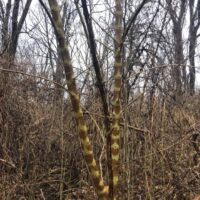
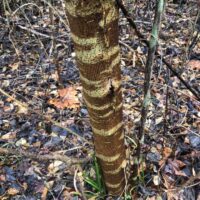
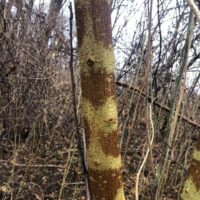
Answer:
Thank you for your Ask an Expert inquiry regarding the identification of this tree and asking if it is invasive. After sharing this with other master arborists we have identified this tree:
Paper Mulberry
Broussonetia papyrifera (L.) L’Her. ex Vent
Mulberry family (Moraceae)
Origin: Japan and Taiwan
Background: Paper mulberry was introduced for use as a fast-growing shade tree. Native Pacific cultures use it to make bark cloth.
Distribution and Habitat: Found from Illinois to Massachusetts, south to Florida and west to Texas, paper mulberry invades open habitats such as forest and field edges. Internationally, it is identified as an invasive weed in over a dozen countries.
Ecological Threat: Once established it grows vigorously, displacing native plants through competition and shading. If left unmanaged, paper mulberry can dominate a site. Its shallow root system makes it susceptible to blowing over during high winds, posing a hazard to people and causing slope erosion and further degradation of an area.
We have several resources to help you as you identify trees and invasives:
Purdue Plant and Pest Diagnostic Laboratory, send in a sample or photos to help identify or diagnose trees and plants (cost $11+), Purdue Extension-Botany and Plant Pathology
Tree Doctor, download app that can be used to help identify and learn more regarding tree diseases Purdue Extension-The Education Store
Certified Arborist, Find an Arborist, International Society of Arboriculture
Invasive Forest Pests in IN, Purdue Extension-Entomology
Indiana Invasive Species Council
Ask an Expert, Purdue Extension-Forestry & Natural Resources
More Resources:
Red and White Mulberry in Indiana, The Education Store, Purdue Extension Depot
Invasive plants: impact on environment and people, The Education Store
Woodland Stewardship for Landowners: EQIP, The Education Store
Invasive Species, Playlist, Purdue Extension – Forestry and Natural Resources YouTube Channel
Woodland Stewardship for Landowners, Playlist
FNR Ask An Expert: Invasive Plant Species, Video
ID That Tree, Playlist
What are invasive species and why should I care?, Got Nature? Blog, Purdue Extension – Forestry and Natural Resources
Report Invasive Species, Purdue Invasive Species
The GLEDN Phone App – Great Lakes Early Detection Network
EDDMaps – Early Detection and Distribution Mapping System
Indiana Department of Natural Resources: Invasive Species
Indiana Invasive Species Council
Cooperative Invasive Species Management Area (CISMA)
Lindsey Purcell, Chapter Executive Director
Indiana Arborist Association
The Purdue Landscape Report, a blog which provides science-based, timely information regarding Midwest landscapes to commercial growers, garden centers, landscapers, arborists and the general public, was recognized with the Extension Division Education Materials Award for Outstanding Blog at the American Society of Horticultural Science convention in August.
The Purdue Landscape Report is a collaborative effort between Purdue Extension specialists and diagnosticians in the areas of horticulture, entomology, plant pathology, urban forestry and turf science. Articles cover everything from tree maintenance to pest and disease problems and management to plant selection.
“Our Purdue Green Industry Team brings together many disciplines and expertise for the industry and homeowners as well as any other university in the country,” Nursey and Landscape Outreach Specialist Kyle Daniel said. “The research and outreach efforts of each member of the team contributes to helping the industry be more sustainable, efficient, environmentally conscious, and profitable. The Purdue Landscape Report is one way that we present science-based information to our stakeholders around the state. In addition to this information being distributed locally, there are many subscribers from across the country.”
The PLR team includes:
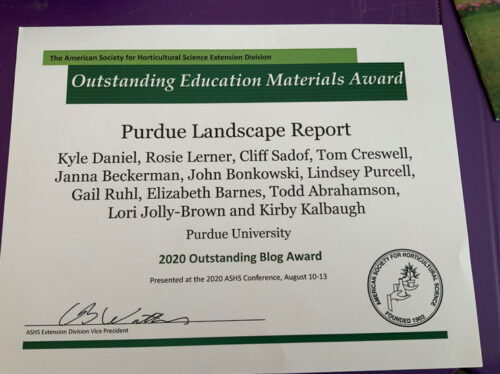 Kyle Daniel – Nursey and Landscape Outreach Specialist, Purdue Horticulture and Landscape Architecture
Kyle Daniel – Nursey and Landscape Outreach Specialist, Purdue Horticulture and Landscape Architecture- Rosie Lerner – Extension Consumer Horticulturist, Purdue Horticulture and Landscape Architecture
- Cliff Sadof – Professor, Entomology Extension Specialist
- Tom Creswell – Clinical Engagement Professor, Director of the Plant & Pest Diagnostic Laboratory; Purdue Botany and Plant Pathology
- Janna Beckerman – Professor of Botany and Plant Pathology
- John Bonkowski – Clerk, Purdue Botany and Plant Pathology
- Lindsey Purcell – Purdue Extension urban forester, Purdue Forestry and Natural Resources
- Gail Ruhl – Visiting Scholar, Purdue Biological Sciences
- Elizabeth Barnes – Exotic Forest Pest Educator, Purdue Entomology
- Todd Abrahamson – Purdue Plant & Pest Diagnostic Lab Secretary
- Lori Jolly-Brown – Extension Events and Communications Coordinator, Purdue Horticulture and Landscape Architecture
- Kirby Kalbaugh – Application and Systems Administrator, Purdue Horticulture and Landscape Architecture
Since launching in February 2018, the Purdue Landscape Report has included more than 144 articles. The website boasted more than 75,000 unique article downloads in 2019. PLR is also sent out in a bi-weekly email newsletter to more than 4,000 subscribers nationwide. The blog has brought in 137,000 unique visitors thus far in 2020.
In August, the Purdue Landscape Report staff also began a live, virtual series every other Wednesday, which addresses articles and hot topics. In just two months, that series has had more than 1,100 views.
Resources
Purdue Landscape Report Team Begins New Virtual Series, Got Nature? Blog, Purdue Extension – Forestry and Natural Resources
The Purdue Landscape Report Issues, Purdue Landscape Report
Tree wounds and healing, Got Nature? Blog
Fall webworms: Should you manage them, Got Nature? Blog
Purdue Landscape Report Facebook Page
In this edition of Wildlife Habitat Hint, Purdue wildlife extension specialist Jarred Brooke shares methods to control the invasive sericea lespedeza. This plant species, though was once used for erosion control and mineland reclamation, is too invasive and of little wildlife value.
If you have any questions regarding wildlife, trees, forest management, wood products, natural resource planning or other natural resource topics, feel free to contact us by using our Ask an Expert web page.
Resources
Sericea Lespedeza: Plague on the Prairie, Purdue Extension
Wildlife Habitat Hint, Playlist, Purdue Extension – Forestry and Natural Resouces
Invasive Species, Playlist
A Woodland Management Moment, Playlist
Woodland Stewardship for Landowners, Playlist
Habitat Help LIVE Q&A – Native Grasses and Forbs for Wildlife, Video, Purdue Extension – Forestry and Natural Resources Youtube channel
Renovating Native Warm-Season Grass Stands for Wildlife: A Land Manager’s Guide, The Education Store, Purdue Extension resource center
Jarred Brooke, Wildlife Extension Specialist
Purdue Department of Forestry and Natural Resources
In this webinar, Purdue Extension forester Lenny Farlee talks about methods of controlling invasive plant species, which include: preventing invasions, early detection and rapid response, control techniques, accessing resources and assistance.
Don’t forget to fill out the Invasive Plants Threaten our Woodlands Part 2, Identification survey after watching the video to share your suggestions or other forest topics you would like to see and to help us learn more about you.
Check out Invasive Plants Threaten our Woodlands: Part 1, Identification (video). This video is also available on Purdue Extension – Forestry and Natural Resources Youtube channel.
If you have any questions regarding wildlife, trees, forest management, wood products, natural resource planning or other natural resource topics, feel free to contact us by using our Ask an Expert web page.
Resources
A Woodland Management Moment, Playlist
Invasive Species, Playlist
Report Invasive Species, Purdue Invasive Species
The GLEDN Phone App – Great Lakes Early Detection Network
EDDMaps – Early Detection and Distribution Mapping System (Report Invasives)
Cooperative Invasive Species Management Area (CISMA)
Indiana Department of Natural Resources: Invasive Species
Indiana Invasive Species Council
Woodland Stewardship for Landowners, Playlist
Invasive plants: impact on environment and people, The Education Store, Purdue Extension resource center
Woodland Invaders, Got Nature? Blog
Hardwood Tree Improvement & Regeneration Center (HTIRC)
Lenny Farlee, Extension Forester
Purdue University, Department of Forestry and Natural Resources
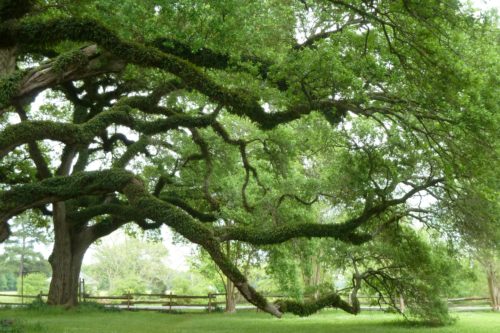 Purdue Landscape Report: The Purdue Landscape Report Team will begin a new, free online series that will start every two weeks on Wednesdays at noon Eastern time zone. The topics and speakers will vary each session, so check out the newsletter every two weeks to find out what follows the next day. You’ll have three ways to attend each session, which you can find below. During each session you’ll be able to ask questions to the speakers on Zoom and Facebook Live. Hope you will join us!
Purdue Landscape Report: The Purdue Landscape Report Team will begin a new, free online series that will start every two weeks on Wednesdays at noon Eastern time zone. The topics and speakers will vary each session, so check out the newsletter every two weeks to find out what follows the next day. You’ll have three ways to attend each session, which you can find below. During each session you’ll be able to ask questions to the speakers on Zoom and Facebook Live. Hope you will join us!
To join the chat on Zoom:
https://purdueextension.zoom.us/j/98937266342
To join the chat via telephone:
US: +1 312 626 6799
To join the chat on Facebook:
https://www.facebook.com/PurdueLandscapeReport
Resources
Purdue Landscape Report
A Woodland Management Moment, Playlist, Purdue Extension – Forestry and Natural Resources Youtube Channel
Invasive Species, Playlist
Woodland Stewardship for Landowners, Playlist
Ask The Expert, Playlist
Surface Root Syndrome, The Education Store, Purdue Extension resource center
Tree Pruning Essentials, The Education Store
Kyle M Daniel, Nursery & Landscape Outreach Specialist
Purdue Horticulture and Landscape Architecture
If you missed the LIVE Q&A about invasive plant species from June 4, 2020, no worries. Now you can view the archived video on our Purdue Extension-FNR YouTube Channel with Lenny Farlee, sustaining hardwood extension specialist, and Liz Jackson, extension specialist with Walnut Council and Indiana Forestry Woodland Owners’ Association (IFWOA), discussing invasive plant species, how to identify them, reporting and controlling techniques.
Here are the resources that were talked about in the video as it will help guide you as you identify invasives.
Resources
Help Stop Invasive Species with PlayCleanGo
Best management practices – Top 10 list (pdf)
Great Lakes Early Detection Network – Download the app at Apple App Store
Eddmaps website – A good place to see mapping and keep track of your reports and overall reports by species or location.
Call DEPP 1-866-NOEXOTIC or email depp@dnr.in.gov
Indiana Native Plant Society – Natives to replace invasives
Alternative Option for Invasive Landscape Plants (pdf)
A Guide to the Regulated Terrestrial Plant Species” (pdf)
Calendar of control- seasonality to treatment (pdf)
Now is the time to control Asian Bush Honeysuckle, Got Nature? Blog, Purdue Extension – Forestry and Natural Resources
County CISMA groups, SICiM website
Work assistance- Contractor list, SICiM website
2020 CISMA Virtual Conference in August – Learn about the impact of invasives, importance of native species, a bit about how to control, SICiM website
Midwest Invasive Plant Network Control Database provides an outline and efficacy rating for control techniques for many common invasive plant species.
Grow Indiana Natives Certification Program – Learn about substitutes for invasive species, Indiana Native Plants Society
Report Invasive
Indiana Invasive Species Council is an excellent doorway site to invasive species information for the state
Contact your local NRCS office for EQIP Brush Control practice, tree planting and habitat development practices, Natural Resources Conservation Service Indiana
Woodland Management Moment – Garlic Mustard, Video, Purdue Extension – Forestry and Natural Resources Youtube Channel
Woodland Management Moment: Asian Bush Honeysuckle, Video, Purdue Extension – Forestry and Natural Resources Facebook Page
Elizabeth Jackson, with Manager Walnut Council/IN Forestry Woodland Owners’ Association (IFWOA) & Engagement Specialist
Purdue University Department of Forestry and Natural Resources
Lenny Farlee, Sustaining Hardwood Extension Specialist
Purdue University Department of Forestry and Natural Resources
Recent Posts
- What Are Invasive Species and Why Should I Care?
Posted: March 25, 2024 in Forestry, How To, Invasive Plant Species, Plants, Woodlands - State of Indiana Proclamation-Invasive Species Week 2024
Posted: February 19, 2024 in Alert, Forestry, Forests and Street Trees, Invasive Animal Species, Invasive Insects, Invasive Plant Species, Urban Forestry, Wildlife, Woodlands - ID That Tree: Native Blackhaw vs. Invasive Winged Burning Bush
Posted: December 8, 2023 in Forestry, Forests and Street Trees, How To, Invasive Plant Species, Plants, Wildlife, Woodlands - Forest Management for the Private Woodland Owner – SIPAC
Posted: November 17, 2023 in Forestry, How To, Invasive Plant Species, Timber Marketing, Woodlands - Now Is The Time To Control Non-Native Bush Honeysuckle
Posted: October 25, 2023 in Forestry, How To, Invasive Plant Species, Woodlands - Cost Assistance for Landowners Planning Conservation Practices
Posted: October 13, 2023 in Forestry, Invasive Plant Species, Natural Resource Planning, Woodlands - Publication: Invasive Plant Series-Tree of Heaven, Ailanthus altissima
Posted: September 12, 2023 in Alert, Forestry, Invasive Plant Species, Plants, Wildlife - IN DNR Division of Entomology & Plant Pathology Shares Kudzu Program
Posted: in Forestry, How To, Invasive Plant Species, Plants, Uncategorized, Wildlife - Tree of Heaven is not so Heavenly-Purdue Landscape Report
Posted: August 9, 2023 in Alert, Forestry, Invasive Plant Species, Wildlife, Woodlands - Question: What is the best treatment to control unwanted trees or brush in woodlands?
Posted: June 13, 2023 in Forestry, How To, Invasive Plant Species, Woodlands
Archives
Categories
- Alert
- Aquaculture/Fish
- Aquatic/Aquaculture Resources
- Ask the Expert
- Christmas Trees
- Community Development
- Disease
- Drought
- Forestry
- Forests and Street Trees
- Gardening
- Got Nature for Kids
- Great Lakes
- How To
- Invasive Animal Species
- Invasive Insects
- Invasive Plant Species
- Land Use
- Natural Resource Planning
- Nature of Teaching
- Plants
- Podcasts
- Ponds
- Publication
- Safety
- Timber Marketing
- Uncategorized
- Urban Forestry
- Webinar
- Wildlife
- Wood Products/Manufacturing
- Woodland Management Moment
- Woodlands